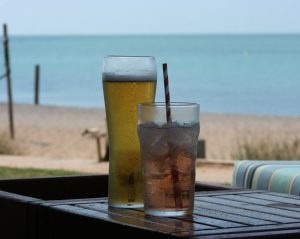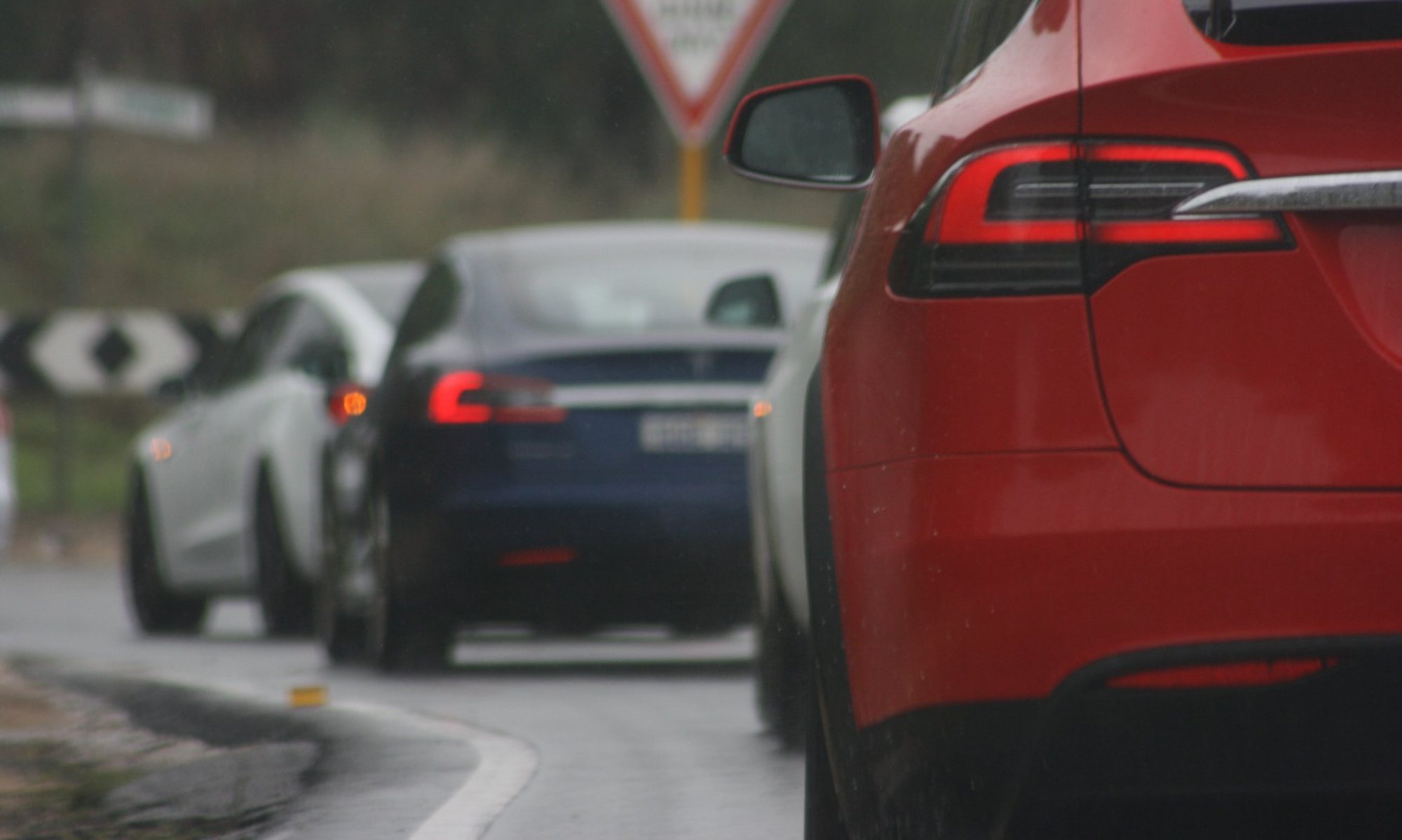It won’t be long before the majority of roads and highways around Australia have fast DC chargers close enough to satisfy the demands of any driver travelling long distance, fast convenient and always reliable, as good if not better than the fuel bowsers around the country and as a bonus far cheaper. Until then long distance electric vehicle driving is possible for those willing to be flexible in their journey. I’m not talking about long distance between Adelaide and Brisbane using superchargers, that’s a stroll in the park in 2019 and shows what’s in store for all EV drivers in all parts of the country. I’m referring to outback travel on roads far from the comfort of the big cities. These types of journeys can certainly be done in the Hyundai Kona and if you pack lightly and don’t mind a challenge a Renault Zoe, but due to the high proportion of Tesla drivers planning long distance trips over the next 12 months this has been written with that brand in mind.
To conduct a long distance trip safely and successfully the 3 Ps are required- Planning, Patience and Politeness, without them it’s best to stay at home.
General vehicle preparation including tyres
Although electric vehicles require far less servicing than a traditional vehicle it is still good practice to schedule a service with Tesla before a long trip if one hasn’t been done recently. Tesla vehicles rarely have issues that make then unable to drive but it’s better for a technician to find a potential fault in the workshop than you finding out on a remote highway on a hot afternoon. If the air conditioner hasn’t been serviced for a few years’ it’s best to get that looked at as even in June-July the aircon will still get a lot of use across large parts of the country. Don’t forget to ask the technician to test the 12 volt battery; this is unlikely to fail completely but having the battery warning light illuminate when you could be 800kms away from the nearest auto electrician could make for a nervous drive.
Tyres need to be in top shape before departing, this should be at the forefront of your thinking if the trip will take you far away from a same day tyre replacement, unless they are near new (less than 15,000kms) you should consider starting the trip with a complete new set, it’s always possible to use the original ones around town at a later date. This may be considered an unnecessary expense but worth it rather than risk spending 3 or more days stuck in a dusty outback roadhouse waiting for a replacement tyre to be trucked in.
Tyre repair kit– yes always carry one but keep in mind this is extra security, tyre repair sealant is not a sufficient solution in many regional areas, it will not repair the damage caused by a pothole, carry a full size spare wheel and tyre combo together with a strong scissor jack and a flat wooden block to rest it on. 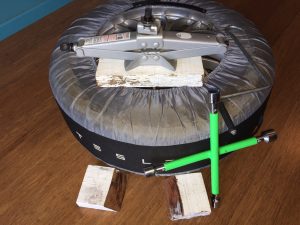 Your vehicle is very unlikely to get a flat tyre but being stuck on a hot and lonely country road for hours on end waiting for vehicle support will remind you many times over to be prepared.
Your vehicle is very unlikely to get a flat tyre but being stuck on a hot and lonely country road for hours on end waiting for vehicle support will remind you many times over to be prepared.
Air suspension – For the many vehicles with air suspension its best to only make use of the low setting when gaining extra range is essential, on many vehicles continual use of the low setting on long trips will result in an uneven tyre wear and a rapid reduction in tyre life.
Accommodation – Firstly try and make use of the locations that have made the effort to install charging facilities, generally most of these locations have a reasonable accommodation offering, there are a few across the Nullarbor that still have 1970s decor but importantly the rooms are clean. Accommodation can appear to be expensive at many locations but considering the high cost to produce electricity and freshwater as well as pay staff it’s understandable. 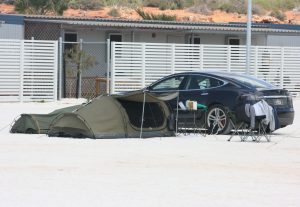 If you’re keen for a bit more adventure take a swag and stay in the campgrounds, the bonus from this is plenty of social contact from fellow travelers wanting to discuss your electric vehicle. It’s important to note that although most overnight stays have free EV charging they can and sometimes do ask for a fee, considering I know of no accommodation in Australia that offers free petrol I think paying for electricity when requested is not beyond reason.
If you’re keen for a bit more adventure take a swag and stay in the campgrounds, the bonus from this is plenty of social contact from fellow travelers wanting to discuss your electric vehicle. It’s important to note that although most overnight stays have free EV charging they can and sometimes do ask for a fee, considering I know of no accommodation in Australia that offers free petrol I think paying for electricity when requested is not beyond reason.
Charging
There’s two different ABCs in charging, the first ABC is Always Be Charging, in other words plug in before starting a conversation with a curious onlooker and check the vehicle is charging via the phone app on regular occasions so the departure time is not delayed. The second ABC is always have charging plans A, B & C, that is when you arrive at a location with a rarely used charging point don’t expect it to be readily available or working just because it’s listed on plug share, plan B is arrive with enough range remaining to find another useable charge point and plan C is prepare to use anything available including a 10amp power outlet. Once you have plugged into 10amp take the time to go for a walk, invariably a useable 3 phase outlet will be found along the way.
Always keep in mind that finding electricity and charging isn’t the issue, the hurdle most times is charging speed, remember that no matter the situation the much maligned 10amp power point will get you out of trouble, it can be excruciatingly slow but useful while looking for a faster alternative.
Public relations
In these early days of electric vehicles every driver and his passengers are ambassadors for the cause when visiting regional locations, many of the owners or managers of locations that have a potential charging point may not have much understanding of electric vehicles and could also be very sceptical of their usefulness, what they do often have is a vast experience with backpackers and other tourists behaving poorly. Never forget that remote locations with a charging point are doing you a favour rather than the other way around, no matter how grumpy the owner/manager/staff may be they control the power supply to your vehicle and for the EVs that follow, stay positive and keep smiling.
Please note:
- Many locations provide free charging for customers, this is a handy bonus for early EV drivers that should not be abused, an EV driver that sits beside their vehicle getting a free charge without making a financial transaction will soon spoil it for others, if you don’t like the food, drink or prices it’s best you go charge elsewhere.
- Do NOT post negative comments on plug share, if you have an issue with the location take it up with the management directly, but before you do be absolutely sure the problem is the location rather than your lofty expectation.
Driving style
How fast should you drive?- As much as possible drive to the conditions, between Adelaide and Cairns that’s fairly straight forward as the charging points are close enough together to hold the speed limits all trip, in many other country areas gaps between useful charging points are larger sometimes requiring energy management. If I could recommend a speed to cruise at it would be 95km/h for two reasons: First off, if you’re charging the car from 3 phase power, 95km/h is very close to the sweet spot between energy consumed and time to replace it, in real terms consistently driving faster than 95km/h will lose you time over a full day; Secondly, and probably something many people overlook, 95km/h keeps the vehicle in the general traffic flow, that is the amount of times per day you’ll be overtaken by a vehicle or need to overtake another vehicle is reduced. Yes you will be passed by a number of sedans and SUVs but they can do that comfortably. Driving at 110km/h then getting stuck behind a road train or caravan for the next 20 minutes is a pointless exercise.
Tailgating trucks – I highly recommend you DON’T do it, it does save energy through slip-streaming but the amount of energy saved will never make up for the damage caused from stones or other items kicking off the trucks rear tyres. If you’re not going to pass a large vehicle sit back 200 metres to allow other vehicles the space to do so.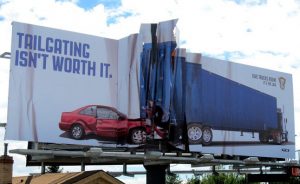
Driving at slow speeds to save energy – There’s enough charging points available now to make this unnecessary for vehicles with a range of 320kms or more, if you need to drive at speeds of less than 85km/h do so in the early morning before most vehicles get on the road, keep in mind that holding up trucks and semi trailers by driving at slow speeds is both dangerous and inconsiderate, many of the other road users are at work and have a time schedule to stick too, remember that before setting off on a long drive.
Equipment needed – As far as charging cables go it depends on the route you’re taking, but if your not sure take that doubtful cable anyway, they are easily packed in the rear storage compartment.
The best all round piece of charging equipment is the Juice Booster 2, yes it is pricey but very versatile and robust, this device is adjustable from 10amp single phase all the way up to 32amp three phase. 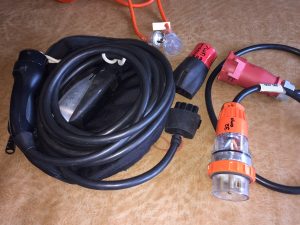 As a back up for that the EVnomics 3 phase tails combined with a Tesla Euro adapter can be rolled up tightly and stored away for emergency use. The most important piece of charging equipment is the one you will rarely require, the Tesla supplied UMC should never leave the vehicle unless in use, this is your plan C, don’t ever leave it at home.
As a back up for that the EVnomics 3 phase tails combined with a Tesla Euro adapter can be rolled up tightly and stored away for emergency use. The most important piece of charging equipment is the one you will rarely require, the Tesla supplied UMC should never leave the vehicle unless in use, this is your plan C, don’t ever leave it at home.
Extension leads – A quality 15amp extension lead will always come in handy, 10 metres is sufficient as combined with the UMC it gives you 17 metres between vehicle and power outlet.
A 32amp 3 phase extension lead may be necessary at some locations, if you have access to one and have the space take it along.
Non charging equipment – everyone has their own list of favourite supplies but here are a few extras that will often come in handy:
4 outlet power board with short cable – very useful when away from the car and you have a multitude of portable devices that need charging. Avoid using power boards to charge any electric vehicle.
Fold out window shades – These are $2 each and are a handy option for blocking the glare through the side windows when driving just after sunrise or before sunset.
Tin fruit and ice coffee in the esky – another handy edition for dealing with an early morning sunrise that shines straight in your eyes and makes driving extremely difficult, just pull over to a safe parking spot, open up the tin and enjoy breakfast while taking in a spectacular sunrise.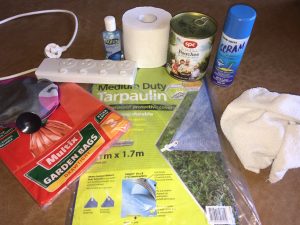
2×1 metre tarp – small enough to store easily in the vehicle, very handy for placing items on when re packing a vehicle on damp or dusty ground.
Spare rags and a large plastic garden bag – on some occasions you’ll go out to the vehicle in the morning and find the charging cables damp, combined with a thin layer of red dirt it’s not something you want to be packing back into the vehicle, use the cloth to wipe off the excess water and pack the whole lot into the garden bag, generally the next charging stop will give you time to tidy up the cables correctly. The rags also come in handy for wiping off red dirt from the tailgate and door gaps, this way you and your passengers don’t transfer dirt into the interior.
Toilet paper and hand soap – all roadhouses and tourist parks provide these items, they’re just rarely available when needed the most.
Insect repellent – forget Sharks, Crocodiles and Snakes, the Mosquito could very well be your biggest health issue in many parts of Australia, have a small tin of repellant ready to use at all times.
A handful of $1 coins and a bag of laundry powder – Most roadhouses have a few washing machines, while the vehicles on charge its a handy time to get some housekeeping done.
One percenters –
Communication 1 – On occasions you may find the staff member behind the counter is new to the location and has no idea an EV charge point even exists, to avoid a communication issue check the comments and photos on plug share so as to pinpoint the charger location before arrival, also ring ahead where possible and get the name of the manager who’ll be on duty the day of your arrival.
Communication 2 – mobile phone reception is hit and miss across large areas, generally it drops out for short sections between towns, roadhouses and mine sites, as a matter of interest the Tesla vehicle appears to hold reception for a touch longer than a stand alone mobile phone.
Power outlets – Many of the older single phase power outlets in regional areas have suffered from the extreme climate conditions as well as endless abuse from tourists, very often it’s impossible to tell if there’s a fault until you plug in, on occasions an outlet will look dodgy, if you’re not sure don’t even consider using it, there’s always another close by that’s in good condition. Three phase outlets are generally tougher but you may find one that has become brittle with old age or has scorch marks around the fitting, same deal applies, plug in to a safe 15amp outlet and take the time to find a 3 phase in better shape.
Breakers tripping off – I’m sure you’ve heard the saying about doing the same thing again and expecting a different result, on most occasions this goes for electricity breakers, continually resetting a breaker at home is one thing but doing it at a tourist park or roadhouse is soon going to attract the attention of the manager who may well decide that electric vehicles are a bit too complicated and are no longer welcome. Also breakers are not always easy to access, the staff may not be familiar with the meter box location, it may need a key or worse still, the breakers are poorly marked due to old age, it can be an exercise in wasted time. The best option is to drop the charging amps via the car and reset the breaker, if it trips again unplug the vehicle and try a completely different electricity circuit. Don’t be greedy, show patience, it’s better to get a slow charge than no charge at all.
If possible avoid using extension leads – The shortest possible cable provides better charging efficiency, less cable heat and less cable for a pedestrian to trip over. Obviously don’t stretch the cable out between the vehicle and power point like a washing line, and yes, I have seen this done.
Secure the plug firmly – 10amp sockets are often very loose, if you’re using a shared power board make sure the socket can’t be accidentally dislodged by another tourist, last thing you need is to wake up in the morning to find charging has stopped and your departure is delayed.
Depart early, arrive early – firstly don’t plan your driving down to the last minute, if you calculate it’s possible to drive X number of kilometres between sunrise and sunset don’t expect to achieve it on every occasion, very often you’ll get held up for short periods of time due to many factors, as well as adding some spare time into the days schedule leave as early as possible, in the early morning there’s far less traffic and also a better opportunity to get some scenic photos. The plan should be to get to your last stop for the day well before dark so it’s easier to set up charging, have a shower and settle down for dinner.
Finish charging the battery just before departure on cool mornings – This method provides just a touch more warmth in the battery and slightly improved range early in the drive.
Don’t stress if early energy consumption is high – Very often on a cool morning energy consumption will appear unusually high even at lower speeds, this is partly due to a cooler battery but mostly due to cold tyres. As the tyres warm up the pressures increase and the energy consumption should return to expected levels, this could take 10-40kms depending on the road surface.
Drive slower at the start of a journey – During a long drive between charging points where energy conservation may be necessary drive slower early and build up some credit in the battery, this is especially the case during early morning starts when there’s less traffic on the road and far more opportunity to sit on 80-90km/h without irritating other drivers, this way if your range projections get messed up due to a strong head wind or rain you won’t find yourself with range anxiety and the need to drive at low speeds on a busy road.
Don’t arrive at an untested location with less than 20kms of range – Untested also refers to the charging point not being used recently by a reliable source, arriving at a power point to find it doesn’t work is one thing, having only a few kilometres of range remaining compounds the issue and limits your options in driving to a usable power point, most Tesla vehicles can drive beyond zero kilometres but some have been known to shut down with 10-15kms remaining, best not to risk it on a lonely country road.
Don’t bypass a useful charging point – this gets back to ABC- Always Be Charging, make use of the charging points when you can, the next one may not be useable, just because your vehicle can do 500kms on a charge doesn’t mean you should, especially if you have to drive slow enough that it holds up other traffic.
Add spare days to the trip – If you’re planning an extended trip add in some lay days in to the schedule, one day per week should cover any unexpected hold ups with slower than planned charging speeds or tyre problems.
Tyre care – This is far more than a one percenter as tyres are one of the most important parts of a vehicle. Correct tyre pressures should be maintained at all times, this provides the best energy consumption, longer tyre life and better handling and braking. Pressures should be checked and set at room temperature for best accuracy, on a warm day tyres may increase in pressure by 6-8psi, this is perfectly normal as long as all 4 tyres increase at similar rates. Most modern cars have a tyre pressure monitoring system (TPMS), check it often to pick up any leaks before they become a serious issue.
Talk to those who have done the trip – Every state and territory has at least one EV owner that has completed a long distance interstate trip, make the effort to get in contact with them and discuss the finer details of locations along the route you’re planning to take, it may very well save you time and money.
Finally, remember you are a tourist first and foremost, don’t let the need for charging dominate your planning, try and attempt to plan charging around tourist activities as much as possible, that way the trip will be a positive experience rather than a burden.
